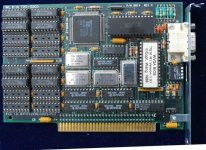modem7
10k Member
I goofed. According to the manual, J6 is only in the 8900D.Yes as per the manual:
J7: "short" ( don't have a j6)
J8: "open"
J9: "all short"
To confirm my understanding, I just now re-read part of the source code for the IBM 5150 BIOS. The only time that the BIOS jumps into the code that may issue the error code of 'one long beep followed by two short beeps' is when the motherboard video switches are set to MDA or CGA.Whilst searching through my stash of parts today i found a 16-bit card with a Trident TVGA9000i-1 chip, I tested it in my 5150 and 5160 and it didn't work, both machines gave out one long and two short beeps,
When the 5150 motherboard switches are set for EGA/VGA, then error indication is issued by the BIOS expansion ROM on the video card. For example, IBM EGA cards issue a 'one long beep followed by three short beeps' error code. It is possible that your Trident TVGA9000i card issues the error code of 'one long beep followed by two short beeps', but I think it more likely that you forgot to change the 5150 motherboard switches to EGA/VGA.
Do you remember setting the 5150 motherboard switches to EGA/VGA ?

